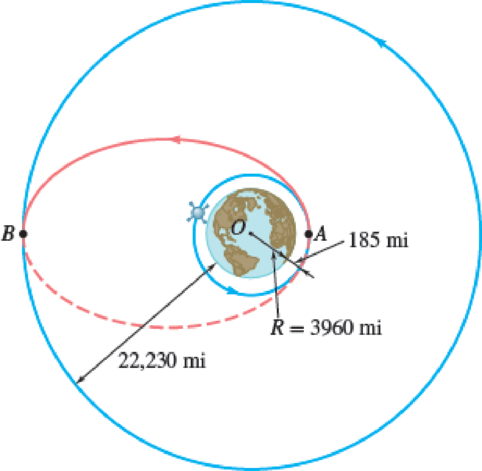
Concept explainers
While describing a circular orbit, 185 mi above the surface of the earth, a space shuttle ejects at point A an inertial upper stage (IUS) carrying a communications satellite to be placed in a geosynchronous orbit (see Prob. 13.87) at an altitude of 22,230 mi above the surface of the earth. Determine (a) the velocity of the IUS relative to the shuttle after its engine has been fired at A, (b) the increase in velocity required at B to place the satellite in its final orbit.
Fig. P13.101

(a)
Find the velocity of the IUS relative to the shuttle after its engine has been fired at A
Answer to Problem 13.101P
The velocity of the IUS relative to the shuttle after its engine has been fired at A
Explanation of Solution
Given information:
The distance from above the earth surface to the circular orbit (x) is
The altitude of the geosynchronous orbit (A) is
The radius of the earth (R) is
The acceleration due to gravity (g) is
Calculation:
Convert the unit of radius of earth (R) from miles to feet using the relation:
Here,
Substitute
Write the expression for the force acting on the spacecraft on the surface of the earth due to gravity
Write the expression for calculating the geocentric force acting on the spacecraft when it is on the surface of earth
Here, G is the universal gravitational constant, M is the mass of the earth and
Substitute
Substitute
Write the expression for the centripetal force acting on the space shuttle carrying satellite rotating around the earth at the given altitude as follows:
Here, m is the mass of the space shuttle,
Write the expression for the geocentric force acting on the spacecraft rotating at the given altitude around the earth (F) as follows;
Equate the equations (1) and (2).
Calculate the altitude of the space shuttle from center of earth at position A
Substitute
Calculate the velocity of space shuttle at point A inertial upper stage
Substitute
Calculate the altitude of the space shuttle from center of earth at position A
Substitute
Calculate the velocity of space shuttle at point B
Substitute
Use the principle of conservation of angular momentum states that in the absence of external torque acting on the body, the angular momentum remains constant and no change of the momentum occurs during the entire process.
Find the velocity at B:
Here,
Substitute
Write the expression for the kinetic energy of the space shuttle at point A
Write the expression for the kinetic energy of the space shuttle at point B
Write the expression for the gravitational potential energy of the space shuttle at position A in the path AB
Write the expression for the gravitational potential energy of the space shuttle at position B in the path AB
Use the principle of conservation of energy states that sum of the kinetic and potential energy of a particle remains constant.
Calculate the speed of the space shuttle at position A
Write the expression for the conservation of energy as follows:
Substitute
Find the velocity at A:
Substitute
Consider the equation (1).
Find the velocity at B:
Substitute
Calculate the velocity of the IUS relative to the shuttle after the engine has been fired at point A
Substitute
Therefore, the velocity of the IUS relative to the shuttle after its engine has been fired at A
(b)
Find the increase in velocity required at B
Answer to Problem 13.101P
The increase in velocity required at B
Explanation of Solution
Given information:
The distance from above the earth surface to the circular orbit (x) is
The altitude of the geosynchronous orbit (A) is
The radius of the earth (R) is
The acceleration due to gravity (g) is
Calculation:
Calculate the increase in the velocity required at B to place the satellite in its final orbit
Substitute
Therefore, the increase in velocity required at B
Want to see more full solutions like this?
Chapter 13 Solutions
Connect 1 Semester Access Card for Vector Mechanics for Engineers: Statics and Dynamics
- Study Area Document Sharing User Settings mylabmastering.pearson.com Access Pearson P Pearson MyLab and Mastering The 150-lb skater passes point A with a speed of 6 ft/s. (Figure 1) Figure 1 of 1 Part A P Course Home b My Questions | bartleby Determine his speed when he reaches point B. Neglect friction. Express your answer to three significant figures and include the appropriate units. με ? VB = Value Units Submit Request Answer Part B Determine the normal force exerted on him by the track at this point. Express your answer to three significant figures and include the appropriate units. ☐ о Α NB = Value Units Submit Request Answer Provide Feedback ? ■Review Next >arrow_forwardmylabmastering.pearson.com Access Pearson P Pearson MyLab and Mastering P Course Home b My Questions | bartleby Study Area Document Sharing User Settings The 100-kg crate is subjected to the forces shown. The crate is originally at rest. The coefficient of kinetic friction between the crate and the surface is μk = 0.2. (Figure 1) Part A Determine the distance it slides in order to attain a speed of 8.1 m/s. Express your answer to three significant figures and include the appropriate units. Figure 500 N 1 of 1 Α S = Value Units Submit Request Answer Provide Feedback ? ■Review Next >arrow_forwardThe differential equation of a DC motor can be described by the following equation Find the transfer function between the applied voltage ( Va)and the motor speed (thetadot m). What is the steady state speed of the motor after a voltage (Va = 10V) has been applied. Find the transfer function between the applied voltage (Va) and the shaft angle (thetadot m) .arrow_forward
- Study Area Document Sharing User Settings Access Pearson mylabmastering.pearson.com P Pearson MyLab and Mastering The crash cushion for a highway barrier consists of a nest of barrels filled with an impact-absorbing material. The barrier stopping force is measured versus the vehicle penetration into the barrier. (Figure 1) Part A P Course Home b My Questions | bartleby Review Determine the distance a car having a weight of 4000 lb will penetrate the barrier if it is originally traveling at 55 ft/s when it strikes the first barrel. Express your answer to three significant figures and include the appropriate units. Figure 1 of 1 36 μΑ S = Value Units Submit Request Answer Provide Feedback ? Next >arrow_forwardStudy Area Document Sharing User Settings mylabmastering.pearson.com Access Pearson P Pearson MyLab and Mastering Part A P Course Home b My Questions | bartleby ■Review The sports car has a mass of 2.5 Mg and accelerates at 6 m/s², starting from rest. (Figure 1) If the drag resistance on the car due to the wind is FD = (10v) N, where v is the velocity in m/s, determine the power supplied to the engine when t = 5 s. The engine has a running efficiency of € = 0.66. Express your answer to three significant figures and include the appropriate units. Figure 1 of 1 о Α ? P = Value Units Submit Request Answer Return to Assignment Provide Feedbackarrow_forwardAccess Pearson Study Area mylabmastering.pearson.com P Pearson MyLab and Mastering Document Sharing User Settings The car in (Figure 1) having a mass of 2 Mg is originally traveling at 2 m/s. Assume 0 = 22°. Figure 1 of 1 Part A P Course Home b My Questions | bartleby ■Review Determine the distance it must be towed by a force F = 4 kN in order to attain a speed of 6 m/s. Neglect friction and the mass of the wheels. Express your answer to three significant figures and include the appropriate units. Α ? S = Value Units Submit Request Answer Provide Feedback Next >arrow_forward
- Derive the Laplace transform of the following functions. Use the definition of Laplace transform. f(t)=sin4t and f(t)=cos2t Auto Controlsarrow_forwardStudy Area Document Sharing User Settings Access Pearson P Pearson MyLab and Mastering Marbles having a mass of 5 g fall from rest at A through the glass tube and accumulate in the can at C. (Figure 1) Figure Aarrow_forwardVC Vc B S TDC -BDC S TQ Tp = Pg A (asne) [1+ % CUSA] At what position (in degrees after top dead center) would you want the peak pressure of combustion to occur to create the maximum torque on the crankshaft? For a 100mm piston digimeter acting on a connecting. rod with a length of 80mm use the equation above to calculate the torque (NIM) on the crankshaft at this crank position for an engine that develops a peak pressure of 135 bararrow_forward
- Access Pearson P Pearson MyLab and Mastering Study Area Document Sharing User Settings The man having a weight of 180 lb is able to run up a 18-ft-high flight of stairs shiwn in (Figure 1) in 4 s. Figure 1 of 1 R mylabmastering.pearson.com Part A P Course Home b My Questions | bartleby Determine the power generated. Express your answer in horsepower to three significant figures. ΜΕ ΑΣΦ. Η vec P = Submit Request Answer Part B ? hp How long would a 100-W light bulb have to burn to expend the same amount of energy? Express your answer to three significant figures and include the appropriate units. HÅ ? t = Value Units Submit Request Answer Provide Feedback Review Next >arrow_forwardThe tension in the belt is 46 lb. Determine the moment of the force F1 about the pin at A. Determine the moment of the force F2 about the pin at A.arrow_forward1. Describe each of the tolerances in the following drawing: 0.01 A 09±0.025 .10±0.01 0.015 AB 6.76 08.51 03±0.05 0.015 MAB 14±0.03 60 14±0.02 12±0.08 0.01 A Barrow_forward
 Elements Of ElectromagneticsMechanical EngineeringISBN:9780190698614Author:Sadiku, Matthew N. O.Publisher:Oxford University Press
Elements Of ElectromagneticsMechanical EngineeringISBN:9780190698614Author:Sadiku, Matthew N. O.Publisher:Oxford University Press Mechanics of Materials (10th Edition)Mechanical EngineeringISBN:9780134319650Author:Russell C. HibbelerPublisher:PEARSON
Mechanics of Materials (10th Edition)Mechanical EngineeringISBN:9780134319650Author:Russell C. HibbelerPublisher:PEARSON Thermodynamics: An Engineering ApproachMechanical EngineeringISBN:9781259822674Author:Yunus A. Cengel Dr., Michael A. BolesPublisher:McGraw-Hill Education
Thermodynamics: An Engineering ApproachMechanical EngineeringISBN:9781259822674Author:Yunus A. Cengel Dr., Michael A. BolesPublisher:McGraw-Hill Education Control Systems EngineeringMechanical EngineeringISBN:9781118170519Author:Norman S. NisePublisher:WILEY
Control Systems EngineeringMechanical EngineeringISBN:9781118170519Author:Norman S. NisePublisher:WILEY Mechanics of Materials (MindTap Course List)Mechanical EngineeringISBN:9781337093347Author:Barry J. Goodno, James M. GerePublisher:Cengage Learning
Mechanics of Materials (MindTap Course List)Mechanical EngineeringISBN:9781337093347Author:Barry J. Goodno, James M. GerePublisher:Cengage Learning Engineering Mechanics: StaticsMechanical EngineeringISBN:9781118807330Author:James L. Meriam, L. G. Kraige, J. N. BoltonPublisher:WILEY
Engineering Mechanics: StaticsMechanical EngineeringISBN:9781118807330Author:James L. Meriam, L. G. Kraige, J. N. BoltonPublisher:WILEY





